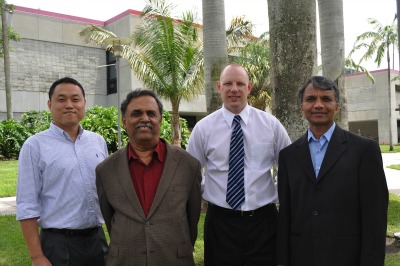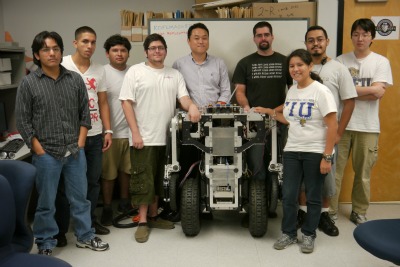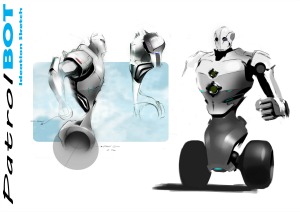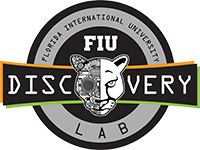source: http://news.fiu.edu/2012/09/fiu-discovery-lab-telebots-could-help-disabled-officers-veterans/42804
Jeremy Robins wants to use robots to bring disabled law enforcement officers back to the force.
To bring his idea to life heäó»s so far given researchers at FIUäó»s Discovery Lab $20,000 of his own money and secured the loan of two custom-built robots from the Institute for Human and Machine Cognition (IHMC) valued at nearly $500,000.
Robins, a lieutenant commander in the U.S. Navy Reserves, describes himself as someone from a service-oriented family who is äóìalways looking for new challenges.äó While serving in Afghanistan, Robins had an idea to help disabled police and military veterans reconnect with the work force while simultaneously combating crime. His idea is to use telerobotics, the combination of telepresence and robots, to allow disabled police and military vets to serve as patrol officers.

Pictured from left to right are Professor Jong-Hoon Kim, director of the Discovery Lab; Professor S. Sitharama Iyengar, director of FIUäó»s School of Computing & Information Sciences; Jeremy Robins, a lieutenant commander in the U.S. Navy Reserves; and Professor Nagarajan Prabakar.
According to the Veterans Administration, there are more than 181,000 Afghanistan and Iraq War veterans collecting disability benefits today. Many of these veterans are unemployed. In addition to military vets, thousands of police are forced to retire every year because of disability. Telebots could change all that.
äóìWe want to use telebots to give disabled military and police veterans an opportunity to serve in law enforcement,äó explained Robins äóìWith telebots, a disabled police officer will be capable of performing many, if not most, of the functions of a normal patrol office äóñ interacting with the community, patrolling, responding to 911 calls, issuing citations. Telerobotics has already begun to make its way into the worlds of medicine, business and the military. Extending it into law enforcement is simply the natural progression of things.äó
Thanks to Robinsäó» help, IHMC (a major grant-funded robotics institute headquartered in Pensacola, Florida) has agreed to loan FIU two robots built for its Urban Warrior Robot (UWR) program, a $2 million Defense Advanced Research Projects Agency (DARPA) initiative. With the help of UWR project lead Jerry Pratt as well as the rest of the IHMC team, robots originally conceived for war will now be filling a whole new purpose in life fighting crime and keeping our communities safe.
As exciting as FIU students now having two military-grade robots to work with is the idea that brought them here. After doing some initial research and learning more about FIUäó»s Discovery Lab, Robins, who has a degree in law but no background in engineering, put his idea in writing in an email to Professor Jong-Hoon Kim, director of the lab at FIUäó»s School of Computing & Information Sciences. The lab was created last spring and is aimed at developing products for the marketplace.
Kim admits he was surprised to receive Robinsäó» email. Itäó»s not everyday someone with no prior affiliation with the university offers to make a gift and presents you with a great idea of what to do with the money.
äóìSo we met face to face and we realized heäó»s a good guy with a good heart, and it gave us a good feeling about this project,äó Kim said. äóìSo, we got interested and wanted to get started.äó
Kim immediately shared the email with the schooläó»s director, Professor S. Sitharama Iyengar, and Professor Nagarajan Prabakar. This, they all agreed, is just the sort of project the lab was interested in developing.
äóìJeremy is the principal person, the idea came from him,äó Iyengar said. äóìHats off to him. He is a great citizen. Somebody giving $20,000 and saying letäó»s do it, thatäó»s really something. The next step is how do we build it? Whatever amount of resources it takes, weäó»ll take care of it.äó

Professor Jong-Hoon Kim (pictured fifth from left), director of the Discovery Lab at FIUäó»s School of Computing & Information Sciences, stands with students and one of the donated robots that are being adapted for the project.
College of Engineering and Computing Dean Amir Mirmiran said the story about how this particular project came about is a testament to the impact of the lab in such a short period of time.
äóìFIUäó»s Discovery Lab is truly an innovation sandbox where our most creative faculty and students are applying their out-of-the-box thinking to tackle real problems with smart solutions at affordable costs,äó Mirmiran said.
Robins is now working with faculty and students in the Discovery Lab to develop an initial prototype based on the research done by IHMC. Preliminary sketches have been drawn up and discussions are ongoing with other universities and private companies regarding possible collaboration on the project.
A group of students from FIUäó»s Discovery Lab was waiting for Robins and Kim when they arrived with the IHMC robots in the very early morning hours. The students have divided into teams to address the various aspects of adapting the robots to this project, including mobility, communications, video and interface capabilities.
The studentsäó» enthusiasm for the project is obvious as they work on the robots and tackle the various hurdles involved in seeing it through to its intended purpose.
äóìItäó»s also very nice to actually help out our vets and disabled officers,äó said Justin Rodriguez, a fourth-year student. äóìThey do so much for us and they certainly deserve second chances. So this is definitely a nice opportunity to do something for them.äó

Early design sketch of telebot being developed at FIUäó»s Discovery Lab.
Theyäó»re looking at telebots offering community policing in high-density public spaces in addition to performing surveillance activities in sensitive areas such as ports and nuclear facilities. The prototype will incorporate video, audio and sensory capabilities, Prabakar explained.
äóìWe want to look at something thatäó»s affordable and can also be deployed so that people can use it,äó Prabakar said. äóìThatäó»s a very important part of this. We want to make sure that the cost is affordable for police departments and others.äóì
The revolutionary thing about this project, Robins said, is that instead of using robots to take a human out of the workforce, theyäó»re using robots to allow a person back into the workforce.
äóìWeäó»ll be using a technology to allow a person to perform a job they would otherwise be unable to perform or not permitted to perform,äó he said. äóìThese men and women joined the police and armed forces in order to serve their country, but now because of injury that ability has been diminished. I donäó»t know how to fix a severed spine, but restoring that ability to serve, and specifically the ability to serve in law enforcementäóîthat I think we can fix.äó
